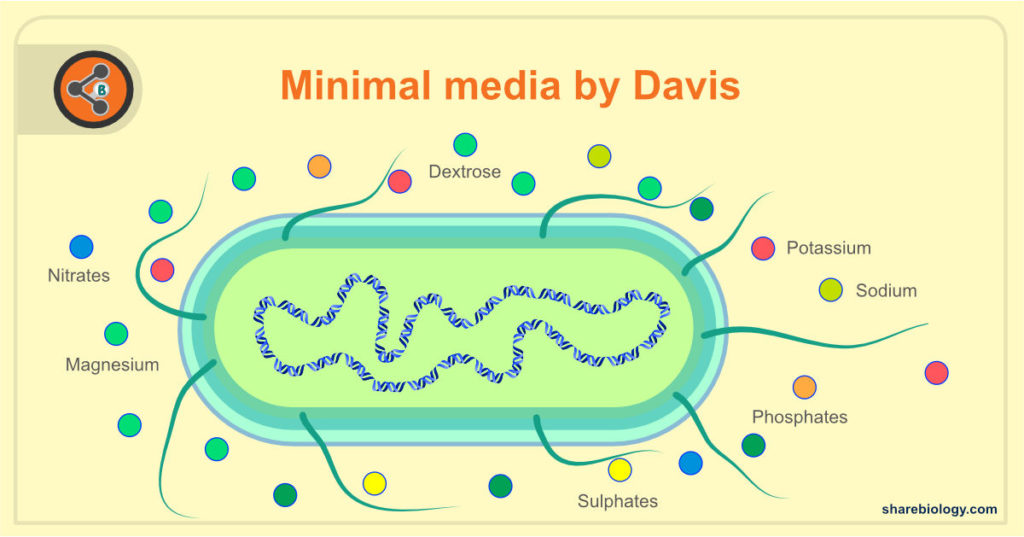Minimal media (Davis formulation)

Introduction
Minimal Broth (first formulated by Davis) is a cultural media with minimal necessities, generally without the presence of amino acids to support the growth of a wild type of microorganisms (e.g. wild type of Escherichia coli)
Minimal media with a single selected agent (either an amino acid, vitamins, nucleic acid, sugar or any other substance) is labelled as supplementary minimal media. And is used to culture-specific lines of auxotrophic mutants (microorganism which requires a specific substance to proliferate, not required by wild-type organisms e.g. nutritional mutants of E.coli which are obtained when the wild type of E.coli is exposed to UV radiation).
Principle
Minimal media is a defined medium with the composition varying on the microorganism being cultured. Typically, this medium contains a carbon source such as a sugar/succinate, various inorganic salts (salts of essential elements like magnesium, nitrogen, phosphorous and sulphur) and water.
The sugars act as carbon and energy source, and phosphates act as a buffering agent while magnesium and ammonium salts serve as sources of ions that stimulate metabolism.
Comparisons between the growth of microbial culture and its mutant form under optimal conditions, in minimal media and supplementary minimal media allows differentiation of wild type cells and mutant cells. The nutritional supplements that are to be added to minimal medium depend upon the type of mutant to be screened as for amino acids, vitamins, nucleic acids or other substances. This difference in growth between the two media indicates a mutant for that particular factor.
Applications
- Minimal media can be used for selection of recombinants or exconjugants.
- This media is often preferred by microbiologists and geneticists to grow “wild-type” microorganisms.
- Minimal media supplemented with extra nutrients aid in the culturing and characterization of auxotrophic mutants.
Composition
| Ingredients | For 100mL | For 500mL | For 1000ml |
|---|---|---|---|
| Dextrose | 0.1 gm | 0.5 gm | 1 gm |
| Ammonium sulphate | 0.1 gm | 0.5 gm | 1 gm |
| Dipotassium phosphate | 0.7 gm | 3.5 gm | 7 gm |
| Monopotassium phosphate | 0.2 gm | 1 gm | 2 gm |
| Sodium citrate | 0.05 gm | 0.25 gm | 0.5 gm |
| Magnesium sulphate | 0.01 gm | 0.05 gm | 0.1 gm |
| Agar | 1.5 gm | 7.5 gm | 15 gm |
| Distilled water | Up to 100 ml | Up to 500 ml | Up to 1000 ml |
Table 1. Composition of Minimal medium.
pH
The pH of the minimal medium is about 7.0 ± 0.2 at 25ºC.
Instruments and other requirements
- Glass beaker
- Conical Flask / Erlenmeyer Flask
- Spatula
- Measuring Cylinder
- pH meter
- Weighing balance
- Distilled Water
- Butter Paper
- Magnetic stirrer and pellet
- Pipettes and tips
- Petri plates and/or test tubes
Preparation
- Weigh the ingredients separately with respect to the volume of the media. (Here, we are considering 1L of the media).
- Suspend the ingredients (except agar) in a glass beaker containing about 900mL of dd H2O.
- Dissolve the components in the beaker using a magnetic stirrer. (Heat may be applied to dissolve the medium completely).
- Adjust the pH of the medium to the desired value.
- Adjust the broth to a final volume of 1L using ddH2O.
- Transfer the broth to conical flask or aliquot into smaller volumes.
- Now add agar accordingly with respect to the volume of the media (i.e., 15 gms agar for 1L of the media).
- Close the mouth of the flask with a cotton plug. Seal it further with paper and rubber band.
- Autoclave for 20 min at 15 psi (1.05kg/cm2) on liquid cycle.
- Mix well and pour into sterile Petri plates.
Alternatively, the commercially available minimal agar media powders can be used. Weigh the mixture of content as prescribed by the manufacturer.
Storage
Store the media plates at 2-8°C until they are utilized. The test sample can be directly streaked on the medium plates and then the plates should be incubated, protected from light.
Prepared Broth Media can be stored at 2-8°C for about 6 months to 2 years and do not allow the products to freeze.
Points to be noted
Some of the reagents have a tendency to precipitate. If you observe precipitation, please do filter sterilization instead of autoclaving.
